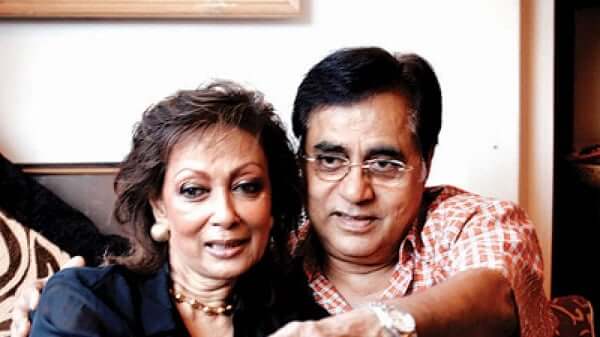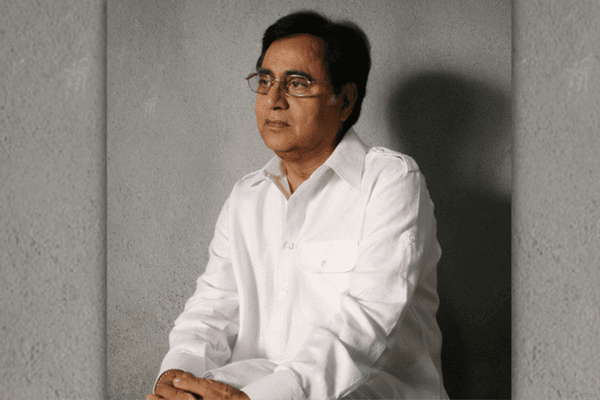Veteran Urdu poet Bashir Badr once shared a “secret”. He said: “I have one enemy — his name is Jagjit. Whatever is mine (poetry), people think it is his (when he sings it). That is why I never introduced him to my wife.”
It was an oblique tribute to Jagjit Singh, whose mellifluous voice imbued pure magic in whatever form of verse — classical to popular to religious to folk — he rendered.
In the course of his decades-long musical journey, Jagjit Singh, endeared himself to generations of music lovers in India and became Indian music’s best-known figure globally after Pandit Ravi Shankar. This was a far cry from his first public appearance — as an uncredited extra in a Rajendra Kumar film.
Amid all this, he gave a new lease of life to ghazal, which he transformed from a preserve of largely upper-class connoisseurs — which it had become due to several political and social factors — to again a genuinely popular musical genre, as its leading practitioners had always intended it to be.
There are some purists who may deprecate his reliance of weaving music into his rendition, even to the point where they say it overshadows the voice, but it is undeniable that no other earlier practitioner even approaches his popularity.
It was, however, an arduous path for Jagjit Singh, who was born Jagmohan Singh Dhiman in Sriganganagar in what was then the princely state of Bikaner.

His father, Sardar Amar Singh Dhiman, who came from Ropar in Punjab, was a surveyor in the Public Works Department and wanted him to follow in his footsteps, or otherwise, become a civil servant.
Dhiman senior, who himself renamed his son Jagjit, was also conscious of his musical talent and allowed him to pursue his interest along with his studies. Jagjit Singh trained under Pandit Chagan Lal Sharma and later Ustad Jamal Khan of Maihar gharana, who instilled in him the nuances of classical music.
Jagjit Singh completed his school education from Sriganganagar and earned his Bachelor’s degree from Jalandhar, where he launched his public music career in 1961 by performing in the local AIR station, and went on to complete his Master’s in History from from the newly-established University of Kurukshetra. His heart, though, remained in music and he surreptitiously went to Bombay in 1965 to try his luck.
His foray turned out to be abortive — some music directors liked his voice but were non-committal. His one high point, as mentioned above, was a bit part in Rajendra Kumar’s anti-war film Aman (1967), where the then still-turbaned Jagjit Singh is one of the friends who welcome the hero, on his return from London, and hugs Rajendra Kumar and lifts him up. Then he got the opportunity to get his voice heard — but in the Gujarati film Bahuroopi, where he performed a bhajan — Laagi Ram bhajan ni lagani.

He also met, fell in love and married Chitra Dutta, setting the frame for a two-decade-plus musical partnership. The duo performed in private soirees and occasional concerts, but fame was still away.
This would only come with the release of their album The Unforgettables (1977), where they finally got acclaim, popularity and acceptance with Jagjit’s rendition of ghazals such as Kafeel Azar’s Baat niklegi to phir door talak jayegi, Amir Meenai’s Sarakti jayee hai rukh naqab ahista ahista, Sudarshan Faakir’s Gham badhe aate hai qatil ki nigahon ki tarah, and duets with Chitra Singh of Firaq Gorakhpuri’s Bahut pahle se un qadmon ki aahat jaan lete hain and Kunwar Mahender Singh Bedi Sahar’s Aaye hai samjhane log.
A major new voice took its place in the glittering firmament of Indian music, and from then on, Jagjit Singh’s stock only continued to grow. He also gained a foothold in Bollywood, scoring the music in Prem Geet (1981), which also featured his first filmi ghazal, the evergreen Hotho se chhu lo tum (Indeevar’s lyrics).
Arth (1982), where Chitra Singh and he provided mesmerising music and also rendered the soundtrack, including such enduring classics like Jhuki jhuki si nazar, Tum itna jo muskura rahe (both Jagjit Singh; lyrics by Kaifi Azmi) and Tu nahin to zindagi mein (Chitra Singh; lyrics Iftikhar Imam Siddiqi) cemented his position.
Saath Saath (1982) did not see them score the music, but Jagjit Singh impressed with his solo Pyaar mujh se jo kiya tumne to, and duets, such as the soothing Tum ko dekha to yeh khayal aaya, and Yeh bata de mujhe zindagi.
Though the duo provided the music for some more films like Sitam (1982) and Raavan (1984), these could not approach the success of Arth. The next break came with his music and rendition in the Gulzar-helmed TV serial Mirza Ghalib (1988) and Ali Sardar Jafri’s Kahkashan (1991-92) on six top modern Urdu poets, including Hasrat Mohani, Josh Malihabadi and Majaz Lakhnavi.
In 1990, Jagjit and Chitra Singh suffered a major tragedy when their teenaged son died in a traffic accident. This made Chitra stop singing entirely, Jagjit Singh continued with his voice getting more mellow and soulful, while retaining its robustness and rhythm.
He also ventured into spiritual and religious renditions at this point. He died in harness — in the midst of a concert series to mark his 70th birthday — in 2011.
Out of his gigantic oeuvre, selecting some of his best can be a tough one, not to mention, a very subjective choice.
But of his ghazals — his rendition of Mir Taqi Mir’s Patta patta, boota boota is in a class by itself — especially the couplet Mehr-o-wafa-o-lutf-e-inayat ek se vaqif inme nahi, and so is of Ibn-e-Insha’s Kal Chaudhvin ki raat thi, where he brings an undercurrent of subtle merriment, especially in the penultimate sher Kooche to tere chhor kar.
And then who can forget the nostalgia-inducing Kagaz ki kashti (Faakir).
From his Punjabi songs, the cheerful Dhai din naal chalti jawani, the ebulliently boisterous Sare pind vich puare payee, and the mischevious ‘Tappe‘ with Chitra Singh demonstrate another side of Jagjit Singh. These may be just a small section, but they showcase Jagjit Singh’s craft — and versatility.
Read More: LISTEN: Remembering Jagjit Singh, the King of Ghazals





